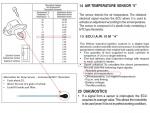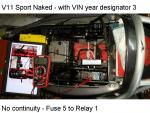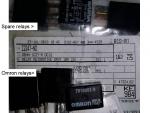-
Posts
988 -
Joined
-
Last visited
-
Days Won
43
Content Type
Profiles
Forums
Events
Gallery
Community Map
Everything posted by MartyNZ
-
US$5.18 + shipping direct from Lubriplate https://www.lubriplate.com/Online-Store/1-75-oz-tubes/DS-ES-1-75-oz-tube.html
-
Sorry mate, but it is time to gently euthanize that story. I have the greatest respect for your expertise and achievements, but you have been misled. Wayne Orwig needs to explain why he has the "facts", and aircraft, auto, and boat manufacturers have been fooled for the last 70 years. Even those little squeeze together wire connectors for lawn irrigation valves use silicon dielectric grease to keep moisture out, and still allow a good electrical connection. . The best examination of the benefits of silicon dielectric grease is here: (link edited) https://www.google.co.nz/url?sa=t&source=web&rct=j&url=https://www.w8ji.com/dielectric_grease_vs_conductive_grease.htm&ved=0ahUKEwjWxZrynPfRAhXGo5QKHUD7Ac0QFggYMAA&usg=AFQjCNHwibqeA9xoggY2S8AvFyuRQxLNQQ There is a lot to wade through, but this guy explains the relative merits of insulating grease, "conductive" grease, and vaseline in a better way than I could. Sure he has an electronics perspective, but connector corrosion is the same for them. My bike has Dow Corning DC-4 silicon dielectric grease in every electrical connection except switches since early 2015, and does not have any electrical faults. I agree that DC4 would be bad for inside switches & relays where an electric arc can happen. For the switches, I used Lubriplate DS-ES. It is a thin grease designed for electrical switches just like our ignition switches. Relays I try to keep dry from both water and grease, except for DC4 on the terminals. I see that some relays have little vents near the bottom that I try to keep clear. Sorry to be a grump, but it pains me to see people who live in wet/humid climates continue to have electrical problems due to corrosion in connectors, when the use of the right product would prevent these problems permanently.
-
On the topic of ignition switch faults, the soldered joints to the wiring can break, but still touch, making an intermittent connection. Vibrations could make or break the connection. See Walterg's experience with this here: http://www.v11lemans.com/forums/index.php?showtopic=18953 See also Chuck's experience here: http://www.v11lemans.com/forums/index.php?showtopic=18606&hl=%2Bbroken+%2Bignition+%2Bwire The comments on wiring loom strain relief are valuable advice.
-
The ignition switch, feed to fuses F4 & F5, and battery terminal connections, & grounds, could be the source of both problems. After that, you may be chasing two separate faults. I'd check your relay bases, if you haven't already done this, see Kiwi_Roy's helpful guide here: http://www.v11lemans.com/forums/index.php?showtopic=15718&hl=%2Brelay+%2Bbase+%2Brepair The safety switch (clutch) bullet connectors under the tank give trouble, so cleaning and gooing them may help if the start relay coil voltage is low from connector resistance. Wriggling wires to make the headlight fail may lead you to the problem. Otherwise, when the headlight next fails, see if the horn and brake lights have failed at the same time. If yes, then check LH switch cluster, 10 wire plug to it, light relay (swap with another), and light fuse connections. Good luck.
-
When I got my bike the Ti CO trim was set to +15. DD got a 2nd hand Ti ECU from Scud, and it was set at +48. So who knows what was standard. Czakky's advice about finishing the basic tune-up first before adjusting CO trim is wise. http://www.v11lemans.com/forums/index.php?showtopic=19652&hl=%2Bfuel+%2Btrim&do=findComment&comment=214563
-
DD, Would you like me to make you a sensor that can slip into one of the pods? It may run OK now with it unplugged, but that just means that the current ECU programming is not right. As the air temp changes, the ECU needs to know about it. Normally that air sensor affects the ECU output of both fuel and ignition advance. It will cost about $2 for me to make a sensor to fit into your pod filter. Then maybe you can adjust the CO trim to suit, so I can get my laptop back. BB, as for comparing fuel trim on your bike with a standard bike, keep in mind that DD's bike has Meinolf's #42 .BIN file loaded into the ECU, which is lots richer than the Ti ECU. And he has done things to improve airflow, meaning that more fuel was needed. You can adjust fuel delivery with CO trim, or get serious with TunerPro and GuzziDiag. Maybe Meinolf could have better advice if you ask him.
-
You know that after you powder-coat the washing machine black, you are going to have to do the dryer too. I hope you will start a new thread on the whiteware project. I find your rebuild efforts inspiring.
-
Does anyone have a foot brake lever they want to sell? I'm looking for the standard MG part, cause I like the position and the look of it. I'd consider any condition except bent or broken. Don't ask why. [update: I bought a second hand one from Ebay UK]
-
I just finished doing this to my bike. Thanks Scud for the tip, and your help getting the improved pin. Instead of a hole, I made a slot to allow the block & pin to slide a little in the brake carrier slot. Then I coated the block with moly dry lube. I don't know if it was necessary, but anyway...
-
OEM Part Name: Bevel Box Needle Roller Bearing (RH side) Moto Guzzi Part Number: 92252225 Needle Bearing/Outer Race, & 92259025 Inner Race. Replacement Part Brand or Source: Any Bearing Retailer, but in NZ: SAECO Wilson were great. Part number: HK2516.2RS Needle Bearing, LRTZ202518 Inner Race 20x25x18. Differences from OEM: No hole in inner race. This is a good thing. Comments: You can't knock the old outer race out from the other side of the bevel box. If heat, rapid freeze, and slide hammer don't get it, then thin-walling with a dremel is your only option. When installing the outer race, the end with writing should face outwards, as it is usually designed to withstand installation press loads better than the unmarked end. After installation, packing it with waterproof wheel bearing grease before fitting the axle should help it last, as rust seems to be the main reason for failure.
-
Did you cure that paint? I've used it, and think that it is great stuff, but the product use sheet says : "Curing Caliper Paint - VHT Caliper Paint only attains its unique properties after correct curing. Bake at 200°F (93°C) for 1 hour. The inherent heat of braking operation will also accomplish curing". (for calipers) It might stay soft if you don't heat it. A portable heater aimed at the forks should do it, 93 deg C won't harm the dampers if you monitor temps with an IR heat sensing gun. Plus it will warm the garage for you.
-
Sorry for using sloppy terminology. Guzzidiag refers to CO trim. This is what I meant to say. http://www.v11lemans.com/forums/index.php?showtopic=19641
-
Those are awesome pipes. They sound good, look good, and weigh a lot less than the stock pipes. They do dent easily though, so be careful. http://www.v11lemans.com/forums/index.php?showtopic=19286&page=2&do=findComment&comment=209717 If you do get a dent, & need to repair them, there is a really helpful guide here: http://www.v11lemans.com/forums/index.php?showtopic=13524&do=findComment&comment=146073 As for writing a Ti map on your old ECU, or fitting the new ECU, there is actually less effort to fit the new ECU. Even though the Ti map is richer than standard, you still need GuzziDiag to check that the fuel trim is a least zero. For me, +15 was better. Best of all for me is Meinolf's map #41. It is excellent! Load his map onto your old ECU, and the new Ti ECU will be left to gather dust. http://www.v11lemans.com/forums/index.php?showtopic=17865&page=14&do=findComment&comment=213970
-
My Brother-in-law visited, so he rented a Triumph Bonneville for the day, and we went to Akaroa. A four hour trip took us all day, as we stopped for lunch at the Hilltop Tavern, and visited little bays and coves on the way. https://goo.gl/maps/ZvhR9uPrjUG2
-
What is the temperature in your garage? Would that goo drain out if you warmed the gearbox with a portable heater?
-
You suggestions seem good to me. I'd be reluctant to get any water inside the gearbox. Bearings can get little pits on the races where water is trapped, then you have ugly noises and metal on the drain plug magnet. Washing the selector is fine, as you can heat it and dry it easily.
-
If it was mine, I'd flush it out with the cheapest solvent available - petrol (gasoline).
-
I got the o-ring seals from Moto International for my injectors. The guy just grabbed an injector from the workshop, and selected seals from a box of assorted seals. I thought "I could have done that myself". But not the wide flat seal in the middle of each injector. I couldn't find a source, so I cleaned them, looked for cracks by stretching them a little, then lubed & refitted. I did sand down the top and bottom faces of the plastic Injector Housing Blocks so that there was some clamping of the o-rings when the screws were tightened. I did this to make sure that the injectors don't jiggle too much under manifold vacuum pulses. BTW, do you want to borrow an injector cleaning kit so you can backwash and check spray pattern?
-
-
I agree, Staburags grease would be great for the spline couplings at each end of the driveshaft. It would squeeze out to allow the splines to clamp together tightly, but still exclude air & water, to reduce fretting corrosion. Drylube in that joint could crush away to allow the spline clamping to loosen, and rapid wear might be next. The spline in the middle of the driveshaft needs regular thin grease, as it slides a lot, and clearances are too tight for a layer of dry lube. The spline from the bevel box to the cush drive can benefit from both dry lube on all contact faces, and when cured, Staburags or similar HT moly grease. It is not a tight spline, so a buildup of drylube is a good thing. My bike is very worn there so lube can only delay the inevitable parts replacements. But still it is plastered with drylube, including the cush drive parts & rubbers, then the spline is greased. CRC Dry Moly is probably fine, especially for your rear wheel cush drive spline, since you can reapply at every tire change. I don't know how durable it is longer term in the clutch, which is harder to access, but still anything is better than nothing. When I get to the clutch on my bike, I will drylube the clutch parts just as Tim described.
-
Can you say more about that? I mean, would you basically spray the whole inside of the flywheel and the transmission input gear? And do you mean anti-seize paste - like the silver (or copper) stuff you put on bolt threads? My BMW specifies a Staburags (NBU 30 PTM) grease for the splines, which is so thick and sticky you have to brush it on. But the splines on the BMW are tiny in comparison to the Guzzi splines. I have some of that. I just put a clutch back together yesterday, but didn't lube it. It's easy-access now... any extra advice appreciated. Gstallon's comment about dry film lubricant is good advice. I've been spraying every spline and sliding surface I uncover with molybdenum disulphide solid film lubricant labelled MIL-PRF-46147D. Everlube makes a spray called Perma-Slik G which meets MIL-PRF-46147C. http://www.skygeek.com/everlube-perm-silk-g-air-dry-mos2-solid-film-lubricant-16-oz-tube-mil-l-23398d-ppsgae.html It is an air drying, MoS2 based solid film lubricant in an epoxy binder system, giving low friction, good corrosion resistance, and high load carrying capacity. Even better is Everlube 620, but the coating needs to be baked at 150ish degrees C, which is inconvenient for some parts. This type of coating won't give any protection from hammering loads, but will extend the life of sliding surfaces. Chuck's comment about using neutral at stop lights is good advice on avoiding hammering loads in the clutch. After the coating is cured, splines still benefit from high temp grease or HT Grease with MoS2 added (but not in the clutch of course). This grease is important to protect against fretting corrosion. I looked up STABURAGS NBU 30 PTM to find out more about it. It looks like a perfect spline grease, but I'd be reluctant to put it in the clutch area as it could attract abrasive dust and become grinding paste. Plus you wouldn't want it to get on the friction faces.
-
Hi DD, If your sensor is feeling hot air off the engine, the ECU will lean the fuel more than it should. Here are a couple of comments about location of the intake air sensor with pod filters. Ed Rosso extended the sensor cable to put the sensor further back into intake air. http://www.v11lemans.com/forums/index.php?showtopic=18906&do=findComment&comment=203711 Kiwi Roy moved the sensor up near the steering head. http://www.v11lemans.com/forums/index.php?showtopic=18960&do=findComment&comment=203548 I can splice in extra length to your cable if you want to try one of these ideas.
-
Peter Kelly of Motokiwi (http://www.motokiwi.co.nz/motoguzzi-news.html) wrote this: "...of great interest this year has been the project put together by Mike Noonan. Mike has built a V35 Guzzi to take on the 350cc world record at Bonneville Salt Flats Speed Week. Mike has developed and fitted a turbo charger and a fuel injection system to this machine. Conditions were too wet this year to run at Bonneville and the event was cancelled. However Mike and his team did get to squeeze an unofficial run on some fairly loose salt and managed to get up to speeds well above the official record. At this stage I'm not sure what his plans are, but hopefully they'll be able to return next year and have another go at knocking it off." https://youtu.be/CrzzmELmRq0 The next Bert Munro?
-

Enjoy life while you can.
MartyNZ replied to doug m's topic in Special place for banter and conversation
I'm very sorry to read of your situation, and thanks for sharing your wisdom. -
The Eagle badge is listed as GU02517700 "adhesive label" in the parts manual. The same part is on the pork chops, and the upper fork clamp. Brace yourself for the price though. Marty






